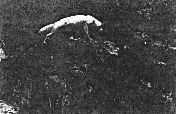

English Name:
-South American red fox or Culpeo fox (6 varieties )
other Names
-Fr: Renard colpeo
-Andenfuchs, Andenwolf, Magellanfuchs
Group
-Dusicyon(Kamp-Foxes)
Lathin Name:
-Dusicyon culpaeus
appearance:
-Body length: 2-3.8 ft; 69-115 cm
-Tail length: 14-16 in; 35-40 cm
-Shoulder height: 16 in; 40 cm
-Weight: 9-26 lb; 4-12 kg
-Bushy tail.
-often larger than the american native red fox
-The zorros are smaller than the culpeo and feature in most other South
American countries...
-Shape Foxlike. Fur short, dense, yellow-brown, downside lightened.Nearly
the size of a german- shephard.
-thin yet sturdily built, with long narrow snouts and long bushy tails.
-high degree of variation within this species is conspicious
-In coloration, a reddish shimmer is always present, but even within single
populations there are animals whose fur ranges from dark brownish.red through
akk shades to yellowish.white.
-A dark stripe of varying width along the back is characteristic.
-The tops of the head and the backs of the ears are predominantls reddish-brown,
as are the flanks and the outsiders of the legs.
-At the upper side of the base of the tail there is a black spot; similarly,
the tip of the tail is dark.
-The belly is yellowish-white.
-They provide a good example of Bergmann's rulem according to which the
physical size of a species increases as it moves from warmer to colder
regions. In the high cordilleras at elevations of 12,800 to 16,000 ft (4000-5000
m), and in the cold climate of Patagonia and Tierra del Fuega, they attain
weights of 18 to 26 lb (8 to 12 kg), whereas in the coastal regions of
Peru, they only reach half that weight.
-large animals are impressive, sturdy teeth amd strong law muscles. (For
this reason, this animal is called the Andes wolf.)
-The exceptionally wide range of color and the considerable differences
in physical size and proportions have previously misled zoologists to describe
many species and subspecies. as a consequence, the task of clarifying the
relationship within the genus Dusicyon as been complicated to the present
day.
Geographic Range:
-Western Southamerica from Äquador, Westperu, Westbolivien, Chile,
Westargentinia to Fireland, Bolivia
-from southern Ecuador throughout the entire Andes chain doen to Tierra
del Fuego and the Patagonian plain.
-primarily denizens of open, dry country.
-They live in valleys and on plateaus of the high Cordilleras, on the slopes
down to sea level, and in the bushes of the Patagonian steppes.
-Adaptive measures to cold regions include the dense fur and physical size;
an adaption to the altitude is the large heart.
Habitat:
-Denizens of open country in the Cordillera and Patagonia; chiefly predators;
territory severak square kilometers (1 km2 = 0.3 mi2)
-Occurrence: Probably still plentiful.
-open, dry country. valleys and on plateaus of the high Cordilleras, slopes
down to sea level, bushes of the Patagonian steppes. Adaptive measures
to cold regions include the dense fur and physical size; an adaption to
the altitude is the large heart.
-The male helps in the rearing process, particularilt in the procurement
of food.
-The parents store food not far from the nursery dens.
-Apart from breeding seasons, colpeo foxes are solitary
Behaviour:
Activity: primarily dusk and night. in the high cordilleras, they extend
their activity to the day as well.
- solitayy
-howl quite frequently in mating season
-The whelps are reared in a den that may be located in rocky caves, among
dense bushes, or in a deserted visaccia cava (a visaccia is a large chinchilla).
-Such a den may have several entrances.
-Colpeo foxes vigorously defend their young against danger.
-They live in pairs during the breeding season.
-Colpeo foxes cover a great deal of territorym as nuch as several square
miles during a 24-hour period.
Reproduction
-mating: Aug.-t
-Gestation period: 62 days (approximately two months)
-Young per birth: 3-6
-Weaning: After at least 2 months
-whelps remain with their parents for another 3 months
Food Habits:
-Plants, fruits, reptiles, small and large rodents, rabbits, sheep
-diet is diverse, but colpeo foxes are probably more definitely carnivorous
than the smaller canids.
-diet changes with the seasons, its distribution, and its physical size.
-Plants, seeds, fruit, and sugarcane are eaten; in Peru, colpeo foxes like
to roam around the cultivated river valleys to assure themselves of a share
in the harvest. Animal components of the diet include insects (especially
grasshoppers), frogs, lizards, birds, rodents, and occasional young vicuna,
rabbits and sheep. They animals also ear refuse from human settlements,
and even chickens and ducks.
-Their hunting methods are well adapted to their quarry.
-Smaller rodents follow certain paths. Larger rodents leave their dens
at particular times.
-The colpeo fox lurks along these paths at those times and catches the
animals with a quick lunge.
-Birds are stalked very cautiously until the colpeo fox is within a short
distance and then seized.
-Larger animals are also hunted.
-The colpeo fox is as adaptable as the red fox with regard to their diet.
-Colpeo foxes penetrate plantations, vineyards, an orchard to find a diverse
vegetarian diet.
-Particularily in Patagonia, they have learned how to catch the European
rabbits that have been introduced there, and sometimes also sheep.
-At night the animals enter human settlements and search through refuse
heaps; slaghterhouses are also popular.
Specialities :
-
others :
--hardly ever kept in zoos, even in South America.
-For this reason, many aspects of their behaviour are unknown.
-With its high degree of adaptability to terrains in both settled and unsettled
areas, the colpeo for will probably not be threatened in the foreseeable
future.
-The colpeo fox has almost no enemies, with the possible exception of puma.
-It is pursued by humans and domesticated dogs, because sheep herders consider
it a dangerous thief; it can, however, defend itself successfully against
dogs.
-The losses among flocks of sheep that can be attributed to colpeo foxes
are almost certainly overestimated.
- General Info about all Kamp-foxes